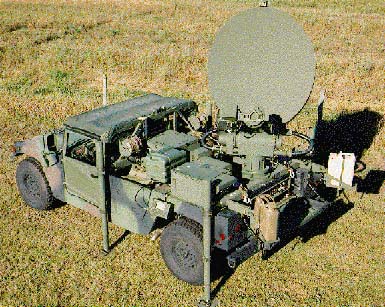SECURE, MOBILE, ANTIJAM, RELIABLE,
TACTICAL TERMINAL (SMART-T)
 |
The Secure, Mobile, Anti-jam, Reliable, Tactical Terminal (SMART-T), a MILSTAR satellite communications transmit-and-receive terminal, is a core element of the Joint Service ground terminal segment of the MILSTAR satellite system. The primary SMART-T mission is multi-channel, near-global extended range connectivity for the Army's Mobile Subscriber Equipment, which is the primary tactical communications equipment for corps and division operations. Operating at both the MILSTAR low and medium data rates, it is designed to provide tactical commanders with secure, jam resistant, extended range, two-way, point-to-point and network voice, data, and video communications. In addition to overcoming the limitations of terrain masking and distance, the SMART-T is designed to operate and survive in severe electronic warfare and nuclear, biological, and chemical environments.
BACKGROUND INFORMATION
The SMART-T entered the EMD phase in May 1992, and the low-rate initial production phase in February 1996. The SMART-T acquisition strategy was designed to deliver terminals in advance of the first medium data rate (MDR) MILSTAR satellite being placed in orbit. The Program Office executed the first of three planned SMART-T full-rate production options in January 1999, based on IOT&E results. Further production options beyond the current 89 terminals were to be supported by additional operational tests in 4QFY99 using an on-orbit MDR satellite. However, the April 30, 1999 launch of the MILSTAR Flight 3 satellite failed and the Reliability Growth Testing (RGT) was behind schedule. The second production option will be supported by an FOT&E that was conducted in September 2001 using Flight 4, the first Medium Data Rate (MDR) satellite.
SMART-T IOT&E was conducted June 1-12, 1998, at Fort Gordon, Georgia, using eight production-representative terminals. The test used an on-orbit MILSTAR satellite for Low Data Rate (LDR) communication and the Massachusetts Institute of Technology (MIT)/Lincoln Laboratory MDR/LDR satellite simulator for MDR communications. SMART-Ts were deployed replicating a typical division and corps Army Common User System. There were two major limitations to SMART-T IOT&E:
- As there was no MDR-capable MILSTAR satellite on orbit, the MIT/Lincoln Laboratory satellite simulator was used to emulate MDR communications. The satellite simulator does not replicate all the physical acquisition and tracking characteristics of an orbiting satellite, nor does it replicate the delay times or footprint associated with an orbiting satellite.
- The Automated Communications Management System (ACMS), an objective communications management tool used for MILSTAR network planning and management control, was not available during the test. An interim planning tool was used to do the network planning for IOT&E. ACMS is still under development but the Army presently is fielding the SMART-T with the Milstar Communications Planning Tool - Integrated (MCPT-i), an interim, less capable tool developed in parallel with ACMS.
The on-board SMART-T diesel generator successfully demonstrated its required reliability of 500 hrs MTBF at 80 percent LCL during RGT in the fall of 1999.
Cold weather setup/teardown testing of a SMART-T was conducted at the Cold Region Test Center (CRTC), Fort Greely, AK, November 8-18, 1999. Thirteen setup and teardown sequences were successfully performed. This test successfully demonstrated that SMART-T can be setup and torn down by a two-man crew wearing cold weather gear, within the 45 minute ORD requirement.
TEST & EVALUATION ACTIVITY
The Program Manager conducted a RGT in FY01 to substantiate the improvements made to SMART-T since IOT&E and to satisfy FOT&E entrance criteria.
SMART-T FOT&E was conducted September 17-25, 2001 at Fort Hood, Texas, using 12 operational terminals. The test used Milstar Flight 4, which is the first MDR on-orbit satellite. SMART-Ts were deployed along with Mobile Subscriber Equipment, the Army Common User System at echelons corps and below. The test was designed to evaluate operational effectiveness and suitability during simulated Army field deployments and maneuvers. FOT&E demonstrated that SMART-T is effective with several minor limitations - message receive rate was 87% versus the required 90% and the current mission planning tool does not provide nuller visibility. FOT&E demonstrated that SMART-T is partially suitable, but great improvements have been made in this area. MTBOMF was estimated at 264 hours (80% confidence level) - still below the 700 hour requirement but well above the 37 hours demonstrated during IOT&E. Other areas for improvement in suitability are Integrated Logistics Support, MANPRINT issues and training. SMART-T has satisfactorily demonstrated that it is survivable.
TEST & EVALUATION ASSESSMENT
DOT&E reported the results of the June 1-12, 1998, IOT&E in our B-LRIP report to Congress in January 1999.
Substantial improvements have been made to the system since IOT&E and the 1999 B-LRIP report to Congress, in particular, with respect to reliability and maintainability. However, operational testing revealed a number of deficiencies that were not identified during developmental testing. The Program Office has identified fixes for most of these deficiencies, and is developing a 'way-ahead' plan to implement them. DOT&E supports conditional materiel release pending verification of correction of remaining deficiencies.
|
NEWSLETTER
|
| Join the GlobalSecurity.org mailing list |
|
|
|

